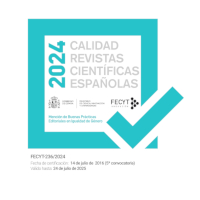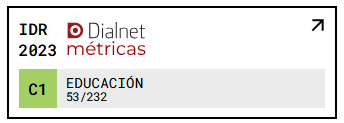Neurodidactic applied to the area of foreign language in Early and Primary Education
teachers’ perceptions
DOI:
https://doi.org/10.18172/con.5218Keywords:
Neuroscience, educational strategies, English learning, Childhood Education, Primary EducationAbstract
Neurodidactics is an emerging discipline which enables the integration in the classroom of strategies based on the functioning of the brain. The objective of this research work is to know to what extent English foreign language teachers in the Childhood Education or/and Primary Education use these strategies that have their origin in neurodidactics and that can be extrapolated to English Foreign Language classroom. This is a descriptive ex post-facto quantitative study for which an ad hoc questionnaire was designed and validated consisting of 15 sociodemographic questions and 35 items valued on a gradual scale from 1 to 5. The participants are 111 teachers from English foreign language from different Educational Centers. The study results indicate that the participants use neurodidactic-based strategies, both in face-to-face English language sessions and in the online sessions.
Downloads
References
Benavidez, V. y Flores, R. (2019). La importancia de las emociones para la Neurodidáctica. Wimblu. Revista Electrónica de Estudiantes de Psicología de la UCR, 14(1), 25-53. DOI: https://doi.org/10.15517/wl.v14i1.35935
Blakemore, S. y Frith, U. (2007). Cómo aprende el cerebro. Las claves para la Educación. Ariel.
Caballero, M. (2019). Neuroeducación en el currículo. Enseñar en el aula inclusiva. Pirámide.
Cañas, L. y Chacón, C. (2015). Aportes de la neurociencia para el desarrollo de estrategias de enseñanza del inglés. Acción Pedagógica, 24(1), 52-61.
Carballo, A. (2017). Neuroeducación: de la neurociencia al aula. Integración: Revista Digital sobre la discapacidad visual, 70, 37-45.
Corpas Arellano, M. D. (2008). Estrategias de aprendizaje en la adquisición de la lengua inglesa. Contextos Educativos, 11, 23-32. DOI: https://doi.org/10.18172/con.594
De Vellis, R. (2003). Scale development: Theory and applications. Sage.
Di Gesù, F. y Seminara, A. (2012). Neurodidáctica y la implicación de emociones en el aprendizaje. Lynx: Panorámica de estudios lingüísticos, 11, 5-39.
Fonseca, G., Rodríguez, L. y Parra, J. (2016). Relación entre funciones ejecutivas y rendimiento académico por asignaturas en escolares de 6 a 12 años. Hacia la Promoción de la Salud, 21(2), 41-58.
García Jiménez, M. y Fernández Cabezas, M. (2020). Relación entre neurociencia y procesos de enseñanza-aprendizaje. International Journal of Developmental and Educational Psychology, 2(1), 281-390. DOI: https://doi.org/10.17060/ijodaep.2020.n1.v2.1857
Garnett, S. (2009). Cómo usar el cerebro en las aulas para mejorar la calidad y acelerar el aprendizaje. Narcea.
González Caballero, F., Cascales Martínez, A. y Gomariz Vicente, M. A. (2021). La presencia de estrategias neurodidácticas en la enseñanza de la Lengua Extranjera Inglesa en Educación Infantil y Educación Primaria. Editum. http://hdl.handle.net/10201/102902
Guillén, J. (2017). Neuroeducación en el aula: de la teoría a la práctica. CreatedSpace Independent Publishing Platform.
Jensen, E. (2010). Cerebro y Aprendizaje. Competencias e implicaciones educativas. Narcea.
Jiménez Catalán, R. M. (1997). La memoria y el aprendizaje del inglés en el Aula. Cauce: Revista Internacional de Filología, Comunicación y sus Didácticas, 20(2), 797-811.
León, O. y Montero, I. (2003). Métodos de Investigación en Psicología y Educación. McGraw-Hill.
Moghaddam, A. y Araghi, S. (2013). Brain-Based Aspects of Cognitive Learning Approaches in Second Language Learning. English Language Teaching, 2(5), 55-61. DOI: https://doi.org/10.5539/elt.v6n5p55
Mora, F. (2013). Neuroeducación. Solo se puede aprender aquello que se ama. Alianza Editorial.
Moravcova, L. y Mad’arova, L. (2016). Neurodidactics and its utilizacion in the field of language teaching. En E. Horská, Z. Kapsdorferová y M. Hallová (eds.), International Scientific Days 2016. The Agri-Food Value Chain: Challenges for Natural Resources Management and Society. Conference proceedings (pp. 634-639). Slovak University of Agriculture. DOI: https://doi.org/10.15414/isd2016.s8.09
Morilla, C. (2016). Principios del Aprendizaje del cerebro y su repercusión en el proceso de Adquisición-Enseñanza de la Lengua Extranjera en la Educación Bilingüe. Encuentro, 25, 76-86.
Paniagua, M. N. (2013). Neurodidáctica: una nueva forma de hacer Educación. Fieds Et Ratio, 7(6), 72-77.
Piserra, M. P. (2003). El proceso de la memoria en relación con la enseñanza/aprendizaje del francés como lengua extranjera. En I. Iñarrea Las Heras y M.ª J. Salinero Cascante (coords.), El texto como encrucijada. Estudios franceses y francófonos (pp. 695-702). Universidad de La Rioja.
Portellano, J. A. (2005). Introducción a la neuropsicología. Mc Graw-Hill.
Prados Véglia, A. y González Ruiz, M. (2018). Intervención sobre las Funciones Ejecutivas (FE) desde el contexto educativo. Revista Iberoamericana de Educación. Neurodidáctica en el aula: transformando la educación, 78(1), 27-42. DOI: https://doi.org/10.35362/rie7813269
Scott, E. (2016). ¿Neurodidáctica aplicada? Una investigación sobre las aplicaciones de la neurodidáctica en la enseñanza de español y en concreto en el libro de texto Caminando 3. [Tesis de Doctorado, Darlana University (Suecia)]. Digitala Vertenskapliga Arkivet.
Siegel, D. y Bryson, T. (2012). El cerebro del niño. 12 estrategias revolucionarias para cultivar la mente en desarrollo de tu hijo. Alba.
Downloads
Published
How to Cite
Issue
Section
License
Copyright (c) 2022 Fuensanta González Caballero, Fuensanta González Caballero, Antonia Cascales-Martínez, María Ángeles Gomariz Vicente, María Ángeles Gomariz Vicente

This work is licensed under a Creative Commons Attribution 4.0 International License.
The authors retain copyright of articles and authorize Contextos Educativos. Revista de Educación the first publication. They are free to share and redistribute the article without obtaining permission from the publisher as long as they give appropriate credit to the editor and the journal.
Self-archiving is allowed too. In fact, it is recommendable to deposit a PDF version of the paper in academic and/or institutional repositories.












